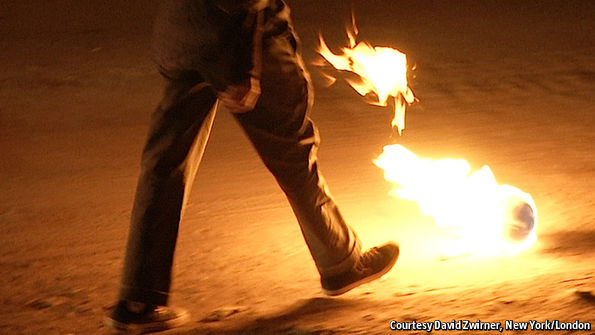David Zwirner London
IN REACTION to the destruction of a city, Picasso painted “Guernica”, depicting the bombing of the Spanish town in 1937. Though the painting was widely celebrated, Jean-Paul Sartre later expressed scepticism that it had ever “won over a single heart to the Spanish cause”. For Sartre the painting sidestepped political reality by turning “cruelty into abstract figures”. This same question, of art’s usefulness in the face of massive human suffering, provides the animating force behind an exhibition by the Belgian-born artist Francis Alÿs, at the David Zwirner Gallery in London, about life in the once prosperous U.S.-Mexico border town of Ciudad Juárez.
It is a well-known, though still shocking, statistic that over 60,000 people were killed in Mexico’s drug wars between 2006-2012. The residents of Ciudad Juárez have suffered a terrible share of this violence over the years—for a time the city had the highest homicide rate in the world. Along with the gang violence, a worrying proportion of murders in the city have become known as feminicidio, the gruesome murders of women. As many as 1,500 women are thought to have been killed in this way in Ciudad Juárez since 1993.
It might seem unlikely that an artist like Francis Alÿs would be able to engage in any meaningful way with life in Ciudad Juárez. He is known for a poetic and absurdist mentality, sending a peacock as his representative to the Venice Biennial of 2001, for example, or arranging for a troop of Household Cavalry to march through the centre of London in 2004. Yet the sensitive and understated works on display here pack a powerful punch. Mr Alÿs has lived in Mexico City since 1986, and frequently collaborates with artists from his adopted home, so he is no uninformed outsider when if comes to life in Mexico.
His films are perhaps best described as surreal documentaries. One short film, entitled “Children’s Game #15: Espejos, Ciudad Juárez, México” (2013) shows a group of children from Ciudad Juárez playing a game where they run through dilapidated buildings and “shoot” each other with the twinkling reflections from fragments of mirror, falling down as though dead in the dust. These kinds of combat games could be played by children anywhere, but in Ciudad Juárez the light-hearted act has troubling echoes, and the ruined surroundings hint at the severe economic depression that has beset the city, with thousands now dead or displaced.
Further showing this decline are the series of old tourist postcards collected by Mr Alÿs and displayed here with all details blacked out, save certain minute elements: a light source or an enigmatic figure. The postcards attest to the fact that Ciudad Juárez, conveniently located on the American border, could once count on a steady tourist industry, as people visited from nearby El Paso or further afield to sample the nightlife that once made it famous (some claim Juárez to be the birthplace of the margarita). However, during the violence of the previous decade Ciudad Juárez became a byword for Mexican drug violence, predictably doing little to encourage tourism. Now, even though the violence has abated, it is proving hard to shake.
The centrepiece of the exhibition is a striking film of Mr Alÿs slowly kicking a flaming football through the dark night of downtown Ciudad Juárez, attracting stares from locals and scaring away stray dogs as police sirens wail in the distance. The vision is haunting, and the details picked up by the camera as it tracks his progress make reference to the city’s many problems: the sex trade, the drug trade, the ambiguous role played by the police. Perhaps the beautiful but oblique film is guilty, as Sartre put it, of reducing cruelty to the abstract. But then so do statistics. This film certainly leaves a more lasting and complex impression than the sad numbers that are usually used to measure the decline of Ciudad Juárez.
From The Economist
